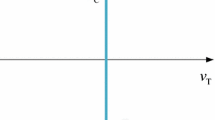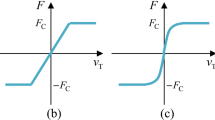Abstract
Friction force models play a fundamental role for simulation of mechanical systems. Their choice affects the matching of numerical results with physically observed behavior. Friction is a complex phenomenon depending on many physical parameters and working conditions, and none of the available models can claim general validity. This paper focuses the attention on well-known friction models and offers a review and comparison based on numerical efficiency. However, it should be acknowledged that each model has its own distinctive pros and cons. Suitability of the model depends on physical and operating conditions. Features such as the capability to replicate stiction, Stribeck effect, and pre-sliding displacement are taken into account when selecting a friction formulation. For mechanical systems, the computational efficiency of the algorithm is a critical issue when a fast and responsive dynamic computation is required. This paper reports and compares eight widespread engineering friction force models. These are divided into two main categories: those based on the Coulomb approach and those established on the bristle analogy. The numerical performances and differences of each model have been monitored and compared. Three test cases are discussed: the Rabinowicz test and other two test problems casted for this occurrence.

























Similar content being viewed by others
References
Al-Bender, F.: Fundamentals of friction modeling. In: ASPE Spring Topical Meeting on Control of Precision Systems (2010)
Altpeter, F.: Friction Modeling, Identification and Compensation. Ph.D. thesis, École Polytechnique Fédérale de Lausanne (1999)
Andreaus, U., Casini, P.: Dynamics of friction oscillators excited by a moving base and/or driving force. J. Sound Vib. 245(4), 685–699 (2001)
Anitescu, M., Potra, F.: Formulating dynamic multi-rigid-body contact problems with friction as solvable linear complementarity problems. Nonlinear Dyn. 14(93), 231–247 (1997)
Armstrong-Hélouvry, B., Dupont, P., Canudas de Wit, C.: A survey of models, analysis tools and compensation methods for the control of machines with friction. Automatica 30(7), 1083–1138 (1994)
Armstrong-Hélouvry, B., Canudas de Wit, C.: Friction modeling and compensation. In: The Control Handbook. CRC Press, Boca Raton (1995)
Åström, K.J., Canudas De Wit, C.: Revisiting the LuGre Model stick–slip motion and rate dependence. IEEE Control Syst. 28(6), 101–114 (2008)
Benson, D.J., Hallquist, J.O.: A single surface contact algorithm for the post-buckling analysis of shell structures. Comput. Method Appl. Mech. Eng. 78, 141–163 (1990)
Berger, E.: Friction modeling for dynamic system simulation. Appl. Mech. Rev. 55(6), 535 (2002)
Bliman, P.A., Sorine, M.: Easy-to-use realistic dry friction models for automatic control. In: 3rd European Control Conference, Rome (Italy), pp. 3788–3794 (1995)
Borello, L., Dalla Vedova, M.D.L.: Dry friction discontinuous computational algorithms. Int. J. Eng. Innov. Technol. 3(8), 1–8 (2014)
Bowden, F.P., Leben, L.: The nature of sliding and the analysis of friction. Proc. R. Soc. Lond. Ser. A Math. Phys. Sci. 169(938), 371–391 (1939)
Canudas de Wit, C., Olsson, H., Åström, K.J., Lischinsky, P.: A new model for control of systems with friction. IEEE Trans. Automat. Control 40(3), 419–425 (1995)
Cha, H.Y., Choi, J., Ryu, H.S., Choi, J.H.: Stick–slip algorithm in a tangential contact force model for multi-body system dynamics. J. Mech. Sci. Technol. 25(7), 1687–1694 (2011)
Chou, D.: Dahl Friction Modeling. Ph.D. thesis, Massachusetts Institute of Technology (2004)
COMSOL: The Structural Mechanics Module. User’s Guide Version 4.3 (2012)
Coulomb, P.C.A.: Theorie des machines simples. Bachelier (1821)
Dahl, P.R.: Solid friction damping of mechanical vibrations. AIAA J. 14(12), 1675–1682 (1976)
Do, T.N., Tjahjowidodo, T., Lau, M.W.S., Phee, S.J.: Nonlinear modeling and parameter identification of dynamic friction model in tendon sheath for flexible endoscopic systems. In: 10th International Conference on Informatics in Control, Automation and Robotics, pp. 5–10 (2013)
Duan, C., Singh, R.: Dynamics of a 3dof torsional system with a dry friction controlled path. J. Sound Vib. 289, 657–688 (2006)
Dupont, P., Armstrong, B., Hayward, V.: Elasto-plastic friction model: contact compliance and stiction. In: Proceedings of the 2000 American Control Conference, vol. 2, pp. 1072–1077 (2000)
Dupont, P., Street, C., Hayward, V., Armstrong, B.: Single state elasto-plastic models for friction compensation. IEEE Trans. Automat. Control 47(5), 787–792 (1999)
FunctionBay Inc: RecurDyn Solver Theoretical Manual (2012)
Galvanetto, U.: Bifurcations and chaos system with dry friction. J. Sound Vib. 204(4), 690–695 (1997)
Geffen, V.V.: A Study of Friction Models and Friction Compensation. Technische Universiteit Eindhoven, Technical Report (2009)
Glocker, C., Pfeiffer, F.: Multiple impacts with friction in rigid multibody systems. Nonlinear Dyn. 7, 471–497 (1995)
Gonthier, Y., McPhee, J., Lange, C., Piedbœuf, J.C.: A regularized contact model with asymmetric damping and dwell-time dependent friction. Multibody Syst. Dyn. 11(3), 209–233 (2004)
Hayward, V., Armstrong, B.: A new computational model of friction applied to haptic rendering. In: Experimental Robotics VI, vol. 250, pp. 403–412. Springer, London (2000)
Hinrichs, N., Oestreich, M., Popp, K.: On the modelling of friction oscillators. J. Sound Vib. 216(3), 435–459 (1998)
Karnopp, D.: Computer simulation of stick slip friction in mechanical dynamic systems. J. Dyn. Syst. Meas. Control 107, 100–103 (1985)
Kermani, M., Patel, R., Moallem, M.: Friction identification in robotic manipulators: case studies. In: Proceedings of IEEE Conference on Control Applications, pp. 1170–1175 (2005)
Kikuuwe, R., Takesue, N., Sano, A., Mochiyama, H., Fujimoto, H.: Fixed-step friction simulation: from classical coulomb model to modern continuous models. IEEE Int. Conf. Intel. Robot Syst. 1, 1009–1016 (2005)
Kim, T.C., Rook, T.E., Singh, R.: Effect of smoothening functions on the frequency response of an oscillator with clearance non-linearity. J. Sound Vib. 263(3), 665–678 (2003)
Lacoursière, C., Linde, M., Lu, Y., Trinkle, J.: A framework for data exchange and benchmarking of frictional contact solvers in multibody dynamics. In: ECCOMAS Thematic Conference on Multibody Dynamics, pp. 2–3. Barcelona (2015)
Liu, H., Song, X., Nanayakkara, T.: Friction estimation based object surface classification for intelligent manipulation. In: IEEE ICRA 2011 Workshop on Autonomous Grasping (2011)
LMS International: LMS Virtual. Lab Motion. User’s Guide (2012)
López, I., Busturia, J., Nijmeijer, H.: Energy dissipation of a friction damper. J. Sound Vib. 278(3), 539–561 (2004)
Marchi, J.A.D.: Modeling of Dynamic Friction , Impact Backlash and Elastic Compliance Nonlinearities in Machine Tools , with Applications To Asymmetric Viscous and Kinetic Friction Identification. Ph.D. thesis, RensselÃęr Polytechnic Institute (1998)
Marques, F., Flores, P., Lankarani, H.M.: On the frictional contacts in multibody system dynamics. In: ECCOMAS Thematic Conference on Multibody Dynamics (2015)
Márton, L., Kutasi, N.: Practical identification method for striebeck friction. In: Proceedings of the 6th International Symposium of Hungarian Researchers, pp. 425–436 (2005)
McMillian, A.J.: A non-linear friction model for self-excited vibrations. J. Sound Vib. 205(3), 323–335 (1997)
Mostaghel, N.: A non-standard analysis approach to systems involving friction. J. Sound Vib. 284, 583–595 (2005)
MSC.Software: Adams/View help (2012)
Muvengei, O.: Computational implementation of LuGre friction law in a revolute joint with clearance. In: Proceedings of the 2012 Mechanical Engineering Conference on Sustainable Research and Innovation, vol. 4, pp. 99–108 (2012)
Olsson, H., Åström, K.J., Canudas De Wit, C., Gäfvert, M., Lischinsky, P.: Friction models and friction compensation. Eur. J. Control 4, 176–195 (1998)
Pennestrì, E., Toso, M., Rossi, V.: ESA multibody simulator for spacecrafts’ ascent and landing in a microgravity environment. CEAS Space J. (2015)
Pennestrì, E., Valentini, P.P., Vita, L.: Multibody dynamics simulation of planar linkages with Dahl friction. Multibody Syst. Dyn. 17, 321–347 (2007)
Pfeiffer, F., Glocker, C.: Multibody dynamics with unilateral contact. Wiley-VCH Verlag GmbH & Co., KGaA, Germany (2004)
Piatkowski, T.: Dahl and lugre dynamic friction models—the analysis of selected properties. Mech. Mach. Theory 73, 91–100 (2014)
Qi, Z., Xu, Y., Luo, X., Yao, S.: Recursive formulations for multibody systems with frictional joints based on the interaction between bodies. Multibody Syst. Dyn. 24, 133–166 (2010)
Rabinowicz, E.: Stick and slip. Sci. Am. 194(5), 109–119 (1956)
Rao, S.S.: Mechanical Vibrations. Addison-Wesley Longman Incorporated, USA (1986)
Richard, C., Cutkosky, M., MacLean, K.: Friction identification for haptic display. Proc. ASME Dyn. Syst. Control Div. 67, 327–334 (1999)
Romano, R.A., Garcia, C.: Karnopp friction model identification for a real control valve. In: Proceedings of the 17th World Congress of The International Federation of Automatic Control, vol. 17, pp. 14906–14911 (2008)
Rooney, G., Deravi, P.: Coulomb friction in mechanism sliding joints. Mech. Mach. Theory 17(3), 207–211 (1982)
Simpack: SIMPACK Documentation (2013)
Tasora, A.: An iterative fixed-point method for solving large complementarity problems in multibody systems. In: Proceedings of XVI GIMC, Bologna (2006)
Thomsen, J.J., Fidlin, A.: Analytical approximations for stick–slip vibration amplitudes. Int. J. Nonlinear Mech. 38, 389–403 (2003)
Threlfall, D.: The inclusion of Coulomb friction in mechanisms programs with particular reference to DRAM. Mech. Mach. Theory 13(4), 475–483 (1978)
Wang, D., Rui, Y.: Simulation of the stick–slip friction between steering shafts using ADAMS. In: International ADAMS User Conference, pp. 1–11 (2000)
Wu, S.C., Yang, S.M., Haug, E.J.: Dynamics of mechanical systems with Coulomb friction, stiction, impact and constraint addition–deletion. Mech. Mach. Theory 21(5), 417–425 (1986)
Author information
Authors and Affiliations
Corresponding author
Rights and permissions
About this article
Cite this article
Pennestrì, E., Rossi, V., Salvini, P. et al. Review and comparison of dry friction force models. Nonlinear Dyn 83, 1785–1801 (2016). https://doi.org/10.1007/s11071-015-2485-3
Received:
Accepted:
Published:
Issue Date:
DOI: https://doi.org/10.1007/s11071-015-2485-3




